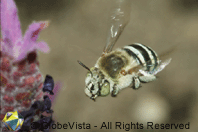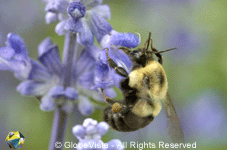Order Hymenoptera
Introduction
 Bees belong to the insect Order Hymenoptera which includes wasps, ants and sawflies. There are believed to be between 10,000 to 20,000 different species of bees. Some bees are social insects like the honey bee, while other bees live very independently of each other. Bees carry pollen by the fine hairs on their legs and body. The honeybee is one of the most important insects on the planet. Some plants need bees to pollinate, without bees there would be no fruit, vegetables or seeds. It is estimated that nearly a third of our daily diet comes from crops pollinated by bees. The most aggressive and deadly of all the bees is the Killer Bee, aka the African Honeybee.
Bees belong to the insect Order Hymenoptera which includes wasps, ants and sawflies. There are believed to be between 10,000 to 20,000 different species of bees. Some bees are social insects like the honey bee, while other bees live very independently of each other. Bees carry pollen by the fine hairs on their legs and body. The honeybee is one of the most important insects on the planet. Some plants need bees to pollinate, without bees there would be no fruit, vegetables or seeds. It is estimated that nearly a third of our daily diet comes from crops pollinated by bees. The most aggressive and deadly of all the bees is the Killer Bee, aka the African Honeybee.
Distinguishing Features
 The first thing that usually comes to mind when thinking about bees, is their sting. Well, interestingly not all bees sting. No, some bees have no sting at all. But the bees that do, can deliver a nasty and painful sting. Branched body hair is one of the main features which distinguish a bee from a wasp, wasps have little or no hair on their bodies.
The first thing that usually comes to mind when thinking about bees, is their sting. Well, interestingly not all bees sting. No, some bees have no sting at all. But the bees that do, can deliver a nasty and painful sting. Branched body hair is one of the main features which distinguish a bee from a wasp, wasps have little or no hair on their bodies.
The hair, along with an electrostatic charge, enables the pollen to stay  attached to the insect. Hair isn’t just confined to the bee’s body, its mouthpart also consists of a hairy tongue (unlike other members in Hymenoptera). The hairy tongue is used for sucking up nectar from flowers.
attached to the insect. Hair isn’t just confined to the bee’s body, its mouthpart also consists of a hairy tongue (unlike other members in Hymenoptera). The hairy tongue is used for sucking up nectar from flowers.
The Honeybee has hair protruding from its eyes. The bee’s mouthpart also has two strong mandibles (jaws) that function like hands. The mandibles are used for eating pollen, building nests, fending off other insects and feeding the larvae. Bees can identify members of their own colony by an odor. The odor is picked up by a scent organ located on the bee’s antennae. Any bee not smelling right is killed instantly. Bees don’t have ears so they communicate through a series of dance moves. For more info click the dance of the bees.
Habitat
 Bees can be found on every continent of the world except Antarctica. Bees live in hives (man-made) or nests which can be found in trees, on branches or in burrows underground. The hives have chambers for storage of nectar & pollen and for their larvae. There is usually only one queen per hive, though in some species there can be more than one queen in a colony. The role of the queen is to produce baby bees known as larvae. Also inside the hives are hundreds of drones, which are males, and thousands of worker bees which are female. Bees provide their own airconditioning for the nest. To cool their house down, the worker bees stand inside the entrance to the nest and fan their wings.
Bees can be found on every continent of the world except Antarctica. Bees live in hives (man-made) or nests which can be found in trees, on branches or in burrows underground. The hives have chambers for storage of nectar & pollen and for their larvae. There is usually only one queen per hive, though in some species there can be more than one queen in a colony. The role of the queen is to produce baby bees known as larvae. Also inside the hives are hundreds of drones, which are males, and thousands of worker bees which are female. Bees provide their own airconditioning for the nest. To cool their house down, the worker bees stand inside the entrance to the nest and fan their wings.
The Pollinator
 Love them or hate them, bees play an important part of the ecosystem. As a pollinator of plants, they carry the pollen from one plant to another, helping the plants to cross-pollinate, ensuring the plant’s survival.
Love them or hate them, bees play an important part of the ecosystem. As a pollinator of plants, they carry the pollen from one plant to another, helping the plants to cross-pollinate, ensuring the plant’s survival.
So how do the bees do this? Well, they are in fact hairy little creatures, covered in fine hairs. The hairs virtually cover their entire bodies, from head to foot. Whilst the bee is busily drinking up the nectar with its tongue, pollen sticks to the fine hairs aided greatly by an electrostatic charge. If you watch a bee closely, you can sometimes see the female bee enter a flower and roll around in the pollen trapping it onto their hairs. You can often see them use their legs to groom themselves, thus rubbing the pollen  around their head and into the storing basket on their hind legs (corbiculum).
around their head and into the storing basket on their hind legs (corbiculum).
The bee then flies off to another flower and then another, pollinating as it goes. The pollen rubs off the bee’s body and hairs, onto the flower’s pistils making the pollination process complete. Bees are such an essential part of the pollination process that some plants rely solely on the bees for their reproduction.
In some cases, farmers have had to rent or hire bees from keepers to help in the pollination of crops such as cherry trees.
So what’s in it for the bee?
Well, bees need the pollen and nectar from flowers for food, especially during the winter seasons when most of the flowers are dead and the bees are bundled up in their nests, hungry and cold. Secondly, the bees need nectar and pollen to create honey to feed their young.
Predators
It isn’t all smooth sailing for the bee, they have many predators. A queen must lay up to 2,000 eggs a day just to keep up with the casualty rate. Birds, bugs, spiders, dragonflies and humans are the bee’s greatest enemies. Birds and dragonflies love feeding on bees, picking off unsuspecting workers in flight. Whilst the bee has to be watchful for flying predators, it must also be wary of enemies on the ground. Lurking in the foliage, waiting for a bee to come in for the sweet nectar, are the Assassin Bugs and Flower & Crab Spiders. They just love ambushing prey and the bee is one of their favourite insects on their menu. Pesticides and insecticides are also one of the bees worst enemies. Spray on flowers and plants can kill the bee or worse, contaminate the pollen which will later be consumed by the colony and sadly result in multiple deaths.
Friend and Foe
The honeybee is the bee with a sting. If you have ever been stung by a bee you know how painful it can be. The sting is a defense mechanism that is probably designed to protect not the individual bee (as the bee dies after inflicting the sting) but more the nest in which the bee is working hard to support. The bee tries to avoid using its sting on its day to day activities of looking for pollen but has no qualms about using it if it thinks its nest is in jeopardy. The sting releases attack pheromones and may trigger a dangerous anaphylactic reaction that is potentially deadly to us humans. The pheromones let other bees known of the potential threat to their nest and if you hang around long enough you may find yourself under attack by more angry bees. Bees can sometimes be found low to the ground in search of their precious pollen. Flowers like dandelions are an attractive food source to the honeybee. Unfortunately for anyone walking barefooted, they are potentially at risk of accidentally treading on the bee, resulting in a sting.
